BY MELINDA J. OVERSTREET
FOR GLASGOW NEWS 1
A little more than 50 years ago, 10 people met for the first time as a board of the directors for the Southcentral Kentucky Historical Society.
Through the years, as with many types of organizations, its membership ebbed and flowed, and the focus and, as a result, it’s name changed, but the original core intent of documenting local history has remained.
Sam Terry has been involved to varying degrees with the organization for more than 40 years and is the current president of of what is now the Barren County Historical Society. He said the group has evolved greatly since its original formation.
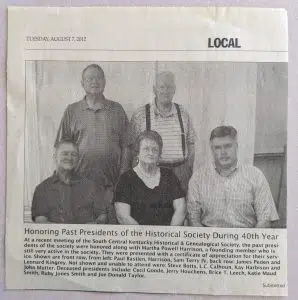
As what is now the Barren County Historical Society celebrates its 50th anniversary, this Glasgow Daily Times newspaper clipping documents past presidents from the first four decades of the organization. MELINDA J. OVERSTREET / FOR GLASGOW NEWS 1
The original incorporates of the society were James M. Simmons, Eva Coe Peden, Charles Howard Peden, Martha Powell Reneau (now Harrison), Marion Vance, Kenneth H. Lee, William Warder Vaughan, Charles T. Woodward, Lauvonne Woodward and Ralph Morgan.
Of those, only Martha Harrison survives.
The organization’s incorporation was Dec. 28, 1972, and the first board meeting, at which the original bylaws were signed, was Jan. 11, 1973, Terry said.
On May 10, 1982, it became the Southcentral Kentucky Historical and Genealogical Society and remained so until Feb. 26, 2015, when the current name was adopted.
Although the original Barren County boundaries used to include what are now portions of other counties, Terry said the organization tends to focus mostly on Barren County as it is now.
“In the late 70s, after Alex Haley’s “Roots” came out, people everywhere became interested in genealogy, and as a result of that, a lot of historical societies began to focus on genealogy and how to do that on your own,” Terry said. “So there was a period that the society was mostly genealogists; however, with the advent of the internet, that has changed all the methods of genealogy and its research. It’s changed a lot, so we’re back to doing more local history and regional history for our programs and I think it’s appealing to a broader audience.”
2023 speakers and programs
This year’s guest speakers have included Barren County native, broadcast journalist and author Bill Goodman in January, kicking off the golden anniversary year.
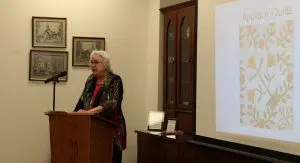
Susan Lyons Hughes, as a guest of the Barren County Historical Society, presents a program on how quilts are mistakenly believed to have been used as secret, coded information for slaves escaping through the efforts of the Underground Railroad. MELINDA J. OVERSTREET / FOR GLASGOW NEWS 1
February brought a program by Susan Lyons Hughes, who formerly worked for the Kentucky Historical Society and as education director at Shakertown at Pleasant Hill. She spoke about how the common belief that quilts were used as coded messages for the Underground Railroad and how scholarly research has shown that to be a mistaken belief.
In March, the “guest” was Terry himself, as he discussed Barren County’s forgotten suffragists.
“We’ve not heard much about suffragists in Barren County, but we did have them,” Terry has said. “We just didn’t record their history, unfortunately.”
Gary Dillard spoke in April about the history of navigation on Green River and how it impacted all of this area of Kentucky, and this month’s meeting is featuring a bit of a field trip with a private tour of a couple of buildings being restored along the Glasgow Public Square.
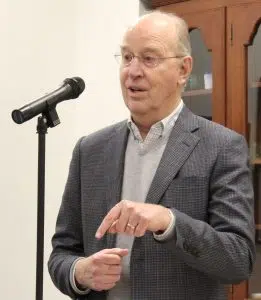
Bill Goodman speaks at the January gathering of the Barren County Historical Society. MELINDA J. OVERSTREET / FOR GLASGOW NEWS 1
“I think that will be a fun thing to see,” Terry said.
Nicky Hughes, who retired as director of the Kentucky Military History Museum in Frankfort is scheduled to speak June 22, and for the July 27 gathering, a historical tour of Morrison Park Historical Site along Tompkinsville Road is on the agenda.
Terry said he’s working on a special program at Fort Williams for October for the 160th anniversary of its construction.
Reflections from an original member
As Harrison sat in the office of her southern Barren County home with the afternoon sun streaming through large windows framed with shelves laden with binders bearing family surnames for which genealogical research had been done and numerous other materials, she began looking through a stack of scrapbooks, prompting memories of past historical society memories.
“I started out, I was interested in genealogy since I was about 12 years old. My daughter was born in ’66, and she had a hearing problem. The doctors recommended that she go to a normal kindergarten, but at that time, nobody would take her because she was so young. So finally, the Presbyterian Church did, and I would take her up there for two hours every day, and rather than go back home, I’d go to the courthouse,” Harrison said.
In the course of spending so much time there doing her research, she met local attorney Marion Vance, and he hired her.
“I hung around there so much Wilmer finally hired me,” she said of former county clerk Wilmer Hodges. “But Marion Vance hired me first to do some research for him, and I did quite a bit for him, and, you know, I just got to know people. I asked Jimmy Simmons – now, Jimmy Simmons lived right across the road from where I was raised, so I knew him all my life, and then I had him in school – and he knew I was interested in it, and told me one day, ‘You go see Eva Peden.’ So I called her up, and she said, ‘Come on over.’ And I went over, and we got to be real good friends. We went out and hunted cemeteries, and she had an awful lot of material.”
Later she met Gladys Wilson at the courthouse and through Peden as well.
“And we got to thinking we needed to do something, because there was too much of it just going away. So we got to talking about it, and one thing led to another, and Marion took it over and Jimmy Simmons, and they really worked with it good. So we decided we would organize a society, and we did,” Harrison said.
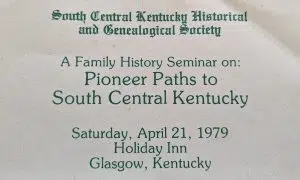
This cover of a program for a family history seminar presented by what later became the Barren County Historical Society is among the items kept by Martha Harrison, an original member of the organization. MELINDA J. OVERSTREET / FOR GLASGOW NEWS 1
Since then, she’s been helping to document the history of the group itself along with that of the local area.
They used to have their meetings at the library, first when it was along West College Street and then after it moved to its current South Green Street home. The meeting location eventually shifted to the South Central Kentucky Cultural Center, she said.
Harrison was among those gathered in January for the Bill Goodman visit.
Terry pointed her out as one of the original members and told her that the time she had devoted to the organization was greatly appreciated.
“Martha worked especially on our quarterly publication for many years and has contributed so much to the research of historical records in Barren County and especially with cemeteries,” Terry said. “She, like many of us, enjoys cemeteries quite a bit, and we like to explore who’s there and try to keep up with those folks.”
He added that the board of the organization had honored Harrison last year as a member emeritus.
‘Traces’ of local history
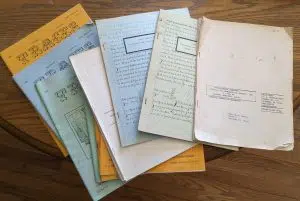
“Traces” was a quarterly publication of what is now the Barren County Historical Society. The entire collection is now available online through the efforts of Nancy RIchey. MELINDA J. OVERSTREET / FOR GLASGOW NEWS 1
Though the organization included several counties in southcentral Kentucky at first, it didn’t have a lot of material yet, sot hey decided to create a publication, Harrison said.
“Traces” was born in 1973.
“We got everything organized, and we decided we’d have a quarterly. Well, Eva and Gladys bought a mimeograph machine. And I got to cut the stencils for the quarterly. And they kept that up till Eva passed away and that was ’82? I believe it was ’82. Gladys couldn’t keep it up, so I took over, and I put out the quarterly for 16 years. I was the editor of it ’til Sandi Gorin moved back here.”
Harrison said she and Gorin worked on it together for a while, and eventually she left it to Gorin.
“We got so Sandi could do it on the computer, and we could have it printed, and we didn’t have to fool with all that mimeograph stuff. That was a mess anyway.”
In each quarterly “Traces,” people’s queries for information were posted. Other content included a list of activities, articles on relevant subjects and a bibliography.
The team also produced an annual index of the prior year’s publications, Harrison said.
She said that in the last several years, there were some complications with getting the newsletter mailed out when they wanted.
“It was a nice little ol’ book; it was thick – about 35, 40 pages every time,” Harrison said. “We found a lot of articles. Some people sent stuff in, and they sent in queries. I think maybe the reason it stopped or it slowed down was because of the computers. Everybody could get anything on Ancestry and everything, and they didn’t have to put up with it. So we kept it up till just a few years ago.”
Nancy Richey, a librarian and archivist at the Kentucky Museum and Library on the Western Kentucky University campus in Bowling Green, worked to make all the issues of “Traces” available online, Terry said. The online archive includes an index Gorin compiled of all of them through 2016.
Other projects
Through the years, the society embarked upon several other projects to help document various aspects of the history of “the Barrens.”
The club commissioned the making of small, brown historical-marker-type roadside signs for many of the cemeteries in the county. People could sponsor a particular sign and the members erected them, Terry said.
Harrison said she thought there were about 100 of them.
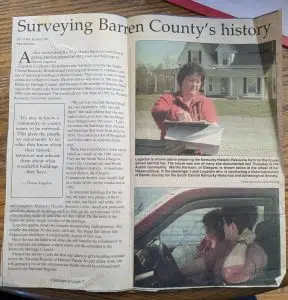
This clipping from the Glasgow Daily Times discusses a historical survey being conducted through what is now the Barren County Historical Society. MELINDA J. OVERSTREET / FOR GLASGOW NEWS 1
“In 1979, we did a seminar that I thought was really interesting but nobody seemed to want to do it again. I’m trying to encourage them to do that again,” she said, as she looked over a copy of the program for the event.
Among the topics were the migratory routes that those who settled here took and genealogical sources.
In 1986 and 1998, maybe, the organization helped organize historical surveys of residential and commercial buildings, noting as many details as they could about the structures, she said.
Once not so long ago, the group hosted a demonstration of grave dowsing – using metal rods to detect where people are buried, their general size and possibly their gender – by Marshall Veach and Randy Jobe.
Fifty years in, Harrison tries to make it to meetings when she can, but mobility challenges make it more difficult for her these days. When she can’t go, she said, she gets updates from Gorin.
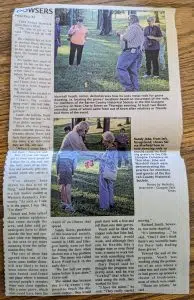
A page from the Glasgow Daily Times contains a portion of a report and photos from when what is now the Barren County Historical Society hosted a dowsing demonstration. MELINDA J. OVERSTREET / FOR GLASGOW NEWS 1
“We need more people. We need young people,” Harrison said.
The Mabel Shelby Wells essay contest took place for several years through the society to help spark students’ interest in history, but then entries waned and too often they “were just copied from the Internet,” she said.
The winner(s) would get a scholarship for $500.
The scholarship fund is still there but they have paused the program for this year with the intention of regrouping and finding a new and/or better way to approach it, Terry said.
Future history
“The society has struggled in various phases of its existence and we’re on an upswing now and invite people to come and learn more about their community and this region through the historical society, and we’d love to have them participate,” Terry said.
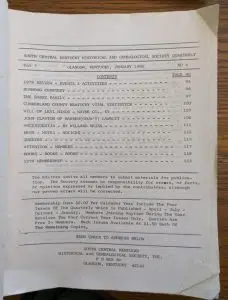
This table of contents from a 1980 issue of “Traces,” the longtime quarterly publication of what is now the Barren County Historical Society, provides readers a glimpse of the material within. MELINDA J. OVERSTREET / FOR GLASGOW NEWS 1
As for attracting younger members, as Harrison suggested they may need to do, he said, “One of the key things is to help people understand that the historical society is not your grandmother’s historical society. We don’t have hoards of little older ladies researching their ancestors and such anymore. It’s a good cross-section of the community – everything from high school students to retirees, and they all have their unique interests in history,” he said.
The “meeting” for the entire group and any others who wish to attend is generally at 6 p.m. on the fourth Thursdays of each month at the cultural center – except for when special field trips or programs like some of the ones named for this year are arranged, Terry said. It is at these gatherings that guest speakers or other programs take place. The board of directors for the society has been meeting at a separate time to discuss the more administrative type items and/or planning sessions, since he became president, he said.
“It just is a bore to people to hear the treasurer’s report and the secretary’s minutes and all of that if you’re not intricately involved in it,” Terry said.
According to the January 1980 issue of “Traces,” membership in the society was $6 per calendar year then. Currently, they are $20 per year for an individual, $25 for a couple, Terry said.
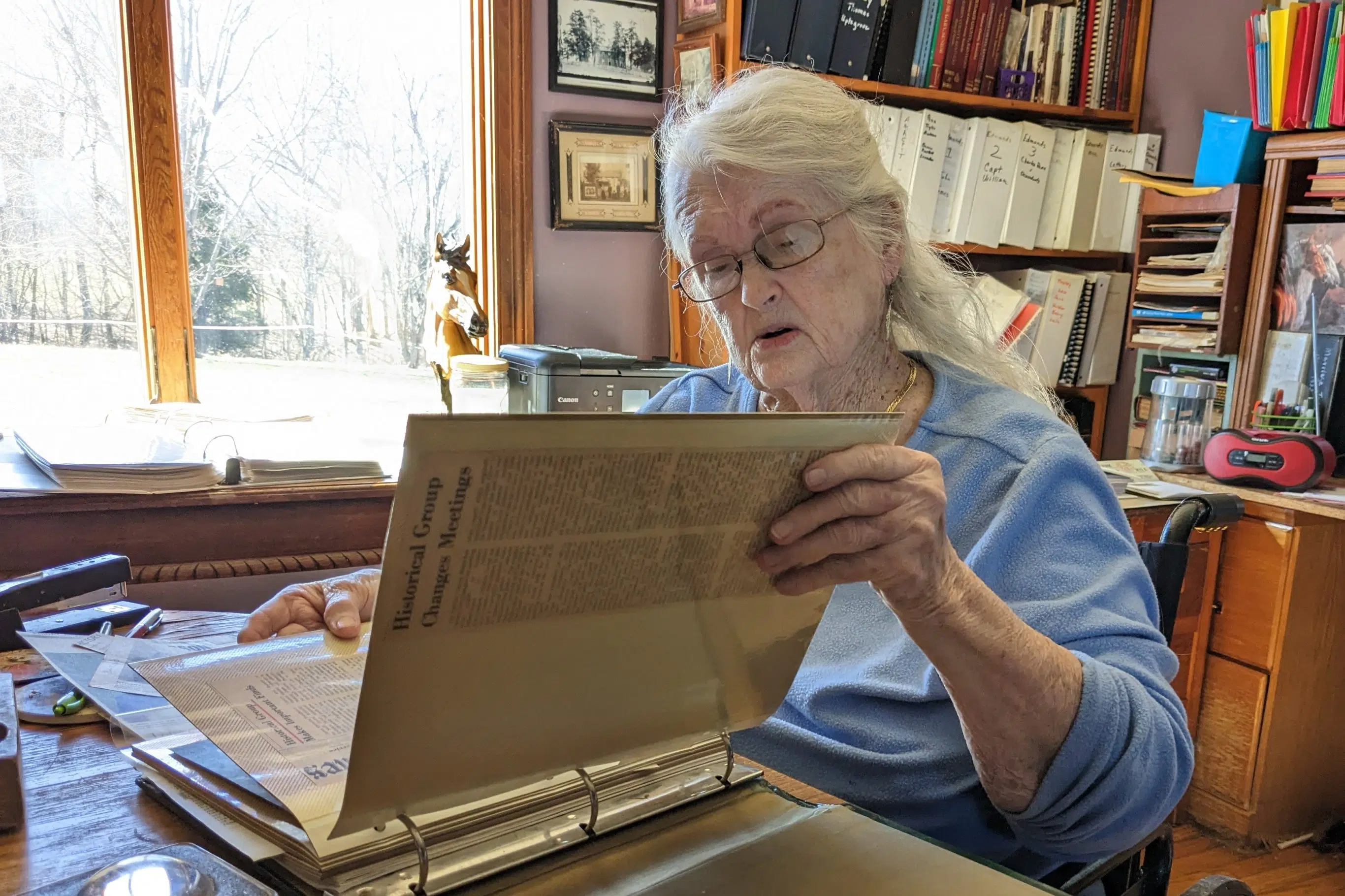
Comments